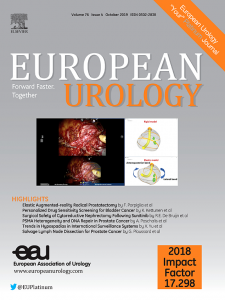European Association of Urology Guidelines on Muscle-invasive and Metastatic Bladder Cancer: Summary of the 2025 Guidelines
IF 25.3
1区 医学
Q1 UROLOGY & NEPHROLOGY
引用次数: 0
Abstract
Background and objective
This publication represents a summary of the updated 2025 European Association of Urology (EAU) guidelines for muscle-invasive and metastatic bladder cancer (MMIBC). The aim is to provide practical recommendations on the clinical management of MMIBC with a focus on diagnosis, treatment, and follow-up.
Methods
For the 2025 guidelines, new and relevant evidence was identified, collated, and appraised via a structured assessment of the literature. Databases searched included Medline, EMBASE, and the Cochrane Libraries. Recommendations within the guidelines were developed by the panel to prioritise clinically important care decisions. The strength of each recommendation was determined according to a balance between desirable and undesirable consequences of alternative management strategies, the quality of the evidence (including the certainty of estimates), and the nature and variability of patient values and preferences.
Key findings and limitations
The key recommendations emphasise the importance of thorough diagnosis, treatment, and follow-up for patients with MMIBC. The guidelines stress the importance of a multidisciplinary approach to the treatment of MMIBC patients and the importance of shared decision-making with patients. The key changes in the 2025 muscle-invasive bladder cancer (MIBC) guidelines include the following: a new recommendation for the use of susceptible FGFR3 alterations to select patients with unresectable or metastatic urothelial carcinoma for treatment with erdafitinib; significant adaption and update of the recommendations for pre- and postoperative radiotherapy and sexual organ–preserving techniques in women; new recommendation related to radical cystectomy and extent of lymph node dissection based on the results of the SWOG trial; recommendation related to hospital volume; new recommendations for salvage cystectomy after trimodality therapy and for the management of all patients who are candidates for trimodality bladder-preserving treatment in a multidisciplinary team setting using a shared decision-making process; significant adaption and update to the recommendation for adjuvant nivolumab in selected patients with pT3/4 and/or pN+ disease not eligible for, or who declined, adjuvant cisplatin-based chemotherapy; and addition of a new recommendation for metastatic disease regarding the antibody-drug conjugate trastuzumab deruxtecan in case of HER2 overexpression; in addition, removal of the recommendations on sacituzumab govitecan as the manufacturer has withdrawn the US Food and Drug Administration approval for this product; update of the follow-up of MIBC; and full update of the management algorithms of MIBC.
Conclusions and clinical implications
This overview of the 2025 EAU guidelines offers valuable insights into risk factors, diagnosis, classification, treatment, and follow-up of MIBC patients and is designed for effective integration into clinical practice.
求助全文
约1分钟内获得全文
求助全文
来源期刊

European urology
医学-泌尿学与肾脏学
CiteScore
43.00
自引率
2.60%
发文量
1753
审稿时长
23 days
期刊介绍:
European Urology is a peer-reviewed journal that publishes original articles and reviews on a broad spectrum of urological issues. Covering topics such as oncology, impotence, infertility, pediatrics, lithiasis and endourology, the journal also highlights recent advances in techniques, instrumentation, surgery, and pediatric urology. This comprehensive approach provides readers with an in-depth guide to international developments in urology.
 求助内容:
求助内容: 应助结果提醒方式:
应助结果提醒方式:


